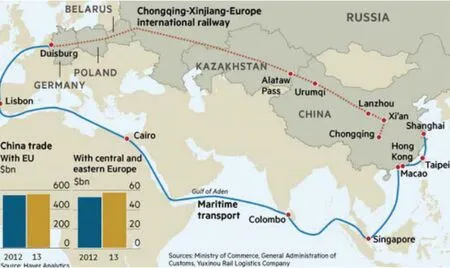“新丝绸之路”带来商机“渝新欧”利好葡萄酒进口商
2014-07-03本刊综合报道
□ 文/本刊综合报道
“新丝绸之路”带来商机“渝新欧”利好葡萄酒进口商
□ 文/本刊综合报道

保税商品交易中心进口葡萄酒交易区,市民可以在家门口淘便宜洋货。 摄影:吴俊琰
8月30日,渝新欧铁路首趟进口汽车整车班列顺利抵达重庆。这趟班列从德国杜伊斯堡出发,途经波兰、白俄罗斯、俄罗斯、哈萨克斯坦,翻越阿拉山口进入中国,行程16天,比传统海运节省了一半以上的时间,而运输成本却相差不大,还避免了海运常常出现的海盗、台风等风险,突显出渝新欧铁路巨大的优势。
自2011年1月28日首趟渝新欧列车成功开行以来,截至目前,渝新欧货物运输总量为1万多标箱,占整个经阿拉山口出入境的中欧班列的80%,开行频率为每周3-4班。
今年,渝新欧公共班列将形成稳定、常态和持续开行态势。根据计划,今年开行的渝新欧公共班列将达到114班,其中去程102班,回程12班。不仅开行班列数量超过过去3年的总和(112班),还将实现公共班列的双向常态运行。
这条全长11000多公里被誉为中欧之间的“新丝绸之路”给重庆带来巨大商机,不仅为“重庆造”出口欧洲提供了便利通道,而且使重庆由中国西部的内陆城市一跃成为全国对欧出口货物的主要集散地,成为欧洲及中亚国家对华出口的中转站,为丝绸之路经济带建设提供了有力支撑。
德国北威州投资促进局局长佩特拉·沃森勒女士和重庆市经信委副主任、市物流办副主任杨丽琼女士都非常看好渝新欧铁路。沃森勒女士表示:“渝新欧铁路连接了世界上两个重要的物流中心——中国的重庆和德国乃至欧洲的杜伊斯堡,这条‘新丝绸之路’将对中德两国之间的货物运输起到重要作用。我们将帮助重庆在北威州以及整个德国建立与企业之间的联系。我们想要看到这条铁路线能够不断地发展壮大,班次能够加密,有更多的货物通过这条铁路在中国与欧洲之间运输。”杨丽琼女士预测,随着渝新欧铁路受到更多中德两国企业的青睐,未来来往中德之间的货运班次增多,尤其是从德国返回中国的货物增多,运价还有进一步降低的空间。
此外,在这条铁路的重庆终点站,全国铁路18个集装箱中心站之一的团结村铁路集装箱中心站已经开通并运营,成为中国西部最大的集装箱中心枢纽站,承担了重庆铁路枢纽及周边300-500公里范围内集装箱运输的组织、编组、调配、信息管理和报关、检验检疫等作业。
于今年10月12日至15日在重庆国际博览中心举办的第91届全国糖酒会也看中了重庆这方面的优势。近几年,来自欧洲的进口葡萄酒大量进入中国大陆市场,为消费者带来更多的选择。以前,无论是通过香港转口,还是直接贸易,进口葡萄酒一般都以海运的方式运到中国,时间大约是36天。如今,通过渝新欧铁路,时间压缩了一半还多,而且更安全。所以对于葡萄酒的进口商来说,渝新欧铁路的开通并常态化,无疑是一个重大利好。
同时,渝新欧铁路也为食品的进口与出口,特别是欧亚国家生鲜食品和农产品的进口,架起了一条充满财富与机遇的金桥。以波兰为例,去年9月,波兰驻华大使塔德乌什·霍米茨基就曾在接受“渝新欧”媒体团采访时表示,中国对欧洲的出口远远大于欧洲对于中国的出口,波兰每年从中国进口的货物是中国从波兰进口的十倍。波兰政府非常希望加大对波兰产品的宣传,特别是高质量的食品,希望把肉类等食品出口到中国。
今年6月23日,渝新欧公司与哈萨克斯坦铁路总公司签署了《合作备忘录》,其中明确了哈方将优先保证“渝新欧”运输、IT、化工、食品、医药等特殊需求,并提供相应的温控物流配套体系和优惠政策。此举意味着在不远的将来,渝新欧铁路将成为一条横贯欧亚大陆的陆上冷链物流配套体系的大动脉。中国对欧亚诸国的食品进出口,特别是生鲜产品进出口交流的频繁,或许将改变中国人和欧亚诸国人民的饮食和消费习惯,丰富人们的餐桌。
而精明的重庆商人,也已经洞见这条新丝绸之路所蕴藏的无限商机。有重庆外贸经商者表示,渝新欧穿越的塔吉克斯坦和俄罗斯等国家,有着丰富的农业资源,把这些国家的农产品通过渝新欧铁路引进到重庆将是一个很好的项目。未来,可以借助渝新欧促进欧洲的畜产品,特别是重庆人喜欢的牛肉和牛肚等牛副产品进口。
参加第91届全国糖酒会,进一步考察重庆,投资重庆,利用渝新欧铁路进口欧洲的葡萄酒和食品,正在那些有眼光的投资者中间形成共识。
"New Silk Road" Creates Business Opportunities Chongqing-Xinjiang-Europe International Railway Benefi ts Wine Importers
On August 30, the first train of import vehicles on the Chongqing-Xinjiang-Europe Railway arrived at Chongqing. The train set out from Duisburg in Germany and passed Poland, Belarus, Russia, Kazakhstan, and Alataw Pass to enter China. The journey took 16 days, which is half the time but around the same cost compared with sea transportation. It also avoids risks including pirates and typhoons, representing a great advantage of the Chongqing-Xinjiang-Europe Railway.
Since the first train started running on January 28, 2011, the railway has shipped over 10,000 TEUs of goods, accounting for 80% of the total goods passing through the Alataw Pass. There are 3 to 4 trains running a week currently.
According to the plan for this year, the public trains on Chongqing-Xinjiang-Europe Railway will run regularly and continuously. In this year, there will be 114 public trains, including 102 runs from Chongqing to the Europe and 12 backwards. The number of runs will exceed the total 112 in the last three years. In addition, the two-way running of public trains will be normalized.
At a length of about 11,000 kilometers, this railway is referred to as the "New Silk Road", connecting China and Europe. It not only functions as a convenient channel for exporting products manufactured in Chongqing to Europe, but also turns Chongqing, an inland city in West China, into China's major distribution center of outbound goods to Europe and a transit stop for European and Central Asian countries to export to China, effectively bolstering the development of the Silk Road Economic Belt.
NRW.INVEST CEO Petra Wassner shares the same optimistic view on the Chongqing-Xinjiang-Europe Railway with Yang Liqiong, Deputy Director of Chongqing Economic and Information Commission and Chongqing Logistics Office. Ms. Wassner said, "The Chongqing-Xinjiang-Europe Railway connects Chongqing in China to Duisburg in Germany, which are two important logistics centers in the world, and establishes a 'New Silk Road', which will play a critical role in cargo transportation between the two countries. We will help Chongqing set up relationships with enterprises in North Rhine Westphalia and even throughout Germany. We hope that this railway can be developed continuously with more intensive schedules, transporting more goods between China and Europe." Ms. Yang Liqiong forecasted that with the increasing popularity of railway transport among Chinese and German enterprises, more trains will be opened up in the future to deliver goods between China and Germany. Especially when goods imported from Germany to China increase, the rate can be further lowered.”
Near the Chongqing terminal, the TuanjiecunRailway Container Hub, one of China's 18 railway container hubs and the biggest container hub in West China, has been put into operation to organize, marshal, schedule and manage railway containers for Chongqing and its neighboring area with a radius of 300-500 km, and to provide customs clearance, inspection, and quarantine.

“新丝绸之路”和“21世纪海上丝绸之路”
The 91st China Food and Drinks Fair, which will be held in the Chongqing International Expo Center on October 12 to 15, leverages this advantage too. In recent years, a large number of European wines have been imported to the mainland market to offer more choices to Chinese consumers. Before the railway was completed, the wines were usually shipped to China by sea for 36 days regardless of whether it was imported directly to the mainland or via Hong Kong. The railway reduces the time by over 50% and makes the transportation safer. As a result, the operation of the railway in a regular manner will further benefi t wine importers.
The railway also equals to a golden bridge of fortune and opportunities to food import and export, particularly to the import of fresh food and agricultural produces from European and Asian countries. Take Poland as an example, the Polish Ambassador to China Tadeusz Chomicki told media in an interview that last September, China’s export to Europe is way more than the other way around, and Poland's import from China was 10 times of its export to China each year. The Polish government hopes very much to promote its products, especially quality food, and export more food like meat to China.
On June 23 2014, Yuxinou (Chongqing) Logistics Co., Ltd. signed a MOU of Cooperation with Kazakhstan Railways to guarantee Kazakhstan that the Chongqing-Xinjiang-Europe Railway will first address the country’s special requirements for transporting IT, chemical, food, and medical products and provide a relevant logistics system with temperature control and preferential policies. This will soon turn the Chongqing-Xinjiang-Europe Railway into an artery of inland coldchain logistics system across the Eurasia Continent. The increasing exchanges of food, especially fresh food, between China and European and Asian countries will provide more choices to the people in these countries and may change their dietary and consumption habits by enriching their dinner table.
Smart Chongqing businessmen have seen the infinite business opportunities brought by the New Silk Road. Some involving in foreign trade said that the countries along the Chongqing-Xinjiang-Europe Railway, such as Tajikistan and Russia, have abundant agricultural resources and it will be profi table to import them to Chongqing through the railway. In the future, more livestock products, especially cattle byproducts such as beef and tripe which are highly popular in Chongqing, can be imported from Europe.
Attending the 91st China Food and Wine Fair for a close look at Chongqing and exporting European wines and food through the Chongqing-Xinjiang-Europe Railway are becoming common tactics for investors with foresight.
